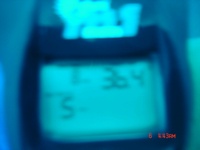
The meaning of term deep diving depends on the level of the diver`s diver training, diving equipment, breathing gas and surface support: in recreational diving, 30 metres / 100 feet may be a "deep dive" in technical diving, 60 metres / 200 feet may be a "deep dive" in surface supplied diving, 100 metres / 330 feet may be a "deep dive" There are particular problems associated with deep dives: High gas consumption. Gas consumption is proportional to pressure - so at 50 metres / 165 feet (6 bar) a diver breathes 6 times as much as on the surface (1 bar). Heavy physical exertion causes even more gas to be breathed. Increased nitrogen narcosis. This causes stress and inefficient thinking in the diver. When breathing air many divers find 40 metres / 130 feet a safe maximum depth. The need to do decompression stops increases with depth. A diver at 6 metres may be able to dive for many hours without needing to do decompression stops. At depths greater than 40 metres / 130 feet, a diver may have only a few minutes at the deepest part of the dive before decompression stops are needed. In the event of an emergency the diver cannot make an immediate ascent to the surface without risking decompression sickness. The diver needs a disciplined approach to planning and conducting dives and needs to carry extra gas for the decompression stops to reduce the risk of being unable to complete the stops. Drifting. If long decompression stops are carried out in a tidal current, the divers may drift away from their boat cover or a safe exit point on the shore. Increased breathing effort. Gas becomes denser and the effort required to breathe increases with depth. Increasing risk of carbon dioxide poisoning. Oxygen toxicity There are several solutions to these problems: Carry larger volumes of breathing gas to compensate for the increased gas consumption and decompression stops. Rebreathers are much more efficient consumers of gas than open circuit scuba. Use helium-based breathing gases such as trimix to reduce nitrogen narcosis and stay beyond the limits of oxygen toxicity. A diving shot, a decompression trapeze or a decompression buoy can help divers return to their surface safety cover at the end of a dive.